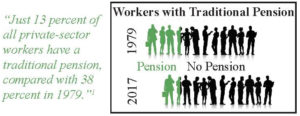The people who helped start the 401(k) revolution in 1981 lament what has become of it. At the time, the hope was just to help supplement a traditional pension program. The reality is that 401(k)s have replaced pension plans as the main retirement savings vehicle.
Herbert Whitehouse, a Human Resources executive for Johnson & Johnson, was one of the first to recommend his executives use a 401(k) as a tax-free way to defer compensation. “We weren’t social visionaries,” he says. They were looking for ways to cut expenses and retain top workers. However, because many companies have jumped on the bandwagon, pensions are becoming a thing of the past.
Traditional pension plans do have their weaknesses: bankruptcies could weaken or wipe out the plan, and it is difficult for employees to transfer the plan to a new company.
Enter the 401(k) with the promise that an employee could have enough savings for retirement. Teresa Ghilarducci, who directed the Schwartz Center for Economic Policy Analysis offered assurances to Union Boards and even to Congress that 3 percent savings would be enough. She now admits the first calculations were a little “too rosy.”
There were other issues policy makers didn’t take into account, such as workers yanking the money out of the 401(k) or choosing investments unsuitable for their ages.
Only 61 percent of eligible workers are currently saving. A whopping 52 percent of households are at risk of running low on money during retirement.4 These are scary numbers. It is no wonder people fear running out of money more than they fear death.5
The nation’s policy makers and some states have made proposals or started initiatives to help change the behaviors of savers and companies. One proposal would mandate retirement savings and the system would be run by the Social Security Administration. However, we are a ways off from having a solution to a societal problem that could be compounded by the Social Security trust fund running dry by 2034.6
The onus is on each one of us to save for retirement and implore our parents, children, friends, and even neighbors to help patch the holes in a sinking ship by saving for retirement.
The bright spots are the people that have benefited from the 401(k). For example, Robert Reynolds could retire comfortably at age 64 after saving for 3 decades. He says the formula is very simple, “If you save at 10 percent plus a year and participate in your plan, you will have more than 100 percent of your annual income for retirement.”7
Like it or not, we live in a world where 401(k) accounts have nearly eliminated pensions. Your financial future is your responsibility. So, make a personal commitment to save for your future.
1. The Champions of the 401(k) Lament the Revolution They Started, Wall Street Journal, Jan 2, 2017
2. The Champions of the 401(k) Lament the Revolution They Started, Wall Street Journal, Jan 2, 2017
3. The Champions of the 401(k) Lament the Revolution They Started, Wall Street Journal, Jan 2, 2017
4. The Champions of the 401(k) Lament the Revolution They Started, Wall Street Journal, Jan 2, 2017
5. http://www.marketwatch.com/story/older-people-fear-this-more-than-death-2016-07-18
6. http://money.cnn.com/2016/06/22/pf/social-security-medicare/
7. The Champions of the 401(k) Lament the Revolution They Started, Wall Street Journal, Jan 2, 2017






